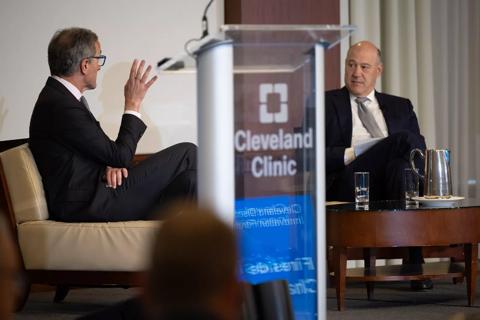Embracing transparency in leadership and a focus on helping others in their career journeys

In October 2020, Meredith Foxx, MSN, MBA, APRN, NEA-BC, became Cleveland Clinic’s Executive Chief Nursing Officer (ECNO). Since then, she has led Cleveland Clinic’s nearly 29,000 nursing caregivers, who serve patients across the globe in inpatient, ambulatory, rehabilitation and home care fields. In this Q&A, Foxx shares insight on her leadership style and what motivates her, as well as advice for others who are new to nursing leadership.
Advertisement
Cleveland Clinic is a non-profit academic medical center. Advertising on our site helps support our mission. We do not endorse non-Cleveland Clinic products or services. Policy
How would you describe your leadership style?
First, it’s important to note that there are a variety of leadership styles out there, each with its own benefits. Also, no two leaders lead exactly the same way. My leadership style is straightforward, open and honest. I aim to be down-to-earth, and I believe in leading with authenticity, positivity and confidence. I have an open-door policy and welcome thoughts and opinions from my colleagues. Every day, I invest time and energy to better understand challenges and devise realistic, optimal solutions. I also value helping others in their own career journeys, professional development and daily practice, and often share personal information about myself, my leadership trajectory and general career experiences that may offer guidance.
What feedback have you received from your team regarding your style?
I’ve received a lot of feedback, including appreciation of my transparency and authenticity, as well as my goal to have a shared vision for our team and the Nursing Institute. I’ve been told that my efforts to help everyone succeed are evident and that the team feels we can comfortably come together as a group to brainstorm and have thoughtful discussion. Some team members have communicated that seeing the way I thoroughly analyze situations has helped them do the same. They noted they now often consider pros and cons from past situations they’ve faced and proactively apply learnings from those scenarios to new challenges. Additionally, they encourage the same thoughtful approach among their own team members.
Advertisement
I was recently asked, “When do you try to leave work daily?” I thought this was interesting, because there are few times when nurse leaders aren’t actively working. However, there is much to be said about balancing work life with home life. While I physically leave work each day at varying times, I want my team and all nursing caregivers to know that balance is important. I answered the question by sharing that I recently added a statement to my email signature that reads, “My working hours and yours may be different. Please don’t feel obligated to reply outside of your normal working hours.”
In any nursing leadership position, leaders need to be available and responsive. However, we must also recognize the importance of our own well-being and allow time to decompress, maintain balance and rely on our colleagues for support.
What drives you?
Personally, I’m driven by the need to be there for my family and friends. I want them to have confidence in my reliability. I’m a do-er and focus on getting things done and getting them done well. Professionally, I’m driven by the opportunity to bring new ideas, insight or alternate ways of thinking to the table. I take calculated risks to constantly improve, enhance and grow. I believe that no one sum is greater than the whole, so I strive to create a work environment where everyone can succeed, and become better, together.
What advice do you have for others who are new to a nursing leadership position?
My predecessor, K. Kelly Hancock, DNP, RN, NE-BC, FAAN, who is now Chief Caregiver Officer at Cleveland Clinic, encouraged me to participate in a leader self-awareness exercise and it was wonderful – something I highly recommend for those who have taken on a new leadership position. The exercise was part of my executive onboarding planning process, led by Cleveland Clinic’s Mandel Global Leadership and Learning Institute, and it involved creating and developing a leader profile.
Advertisement
The profile is a quick and simple tool designed to enhance the effectiveness and quality of communication among team members, increase trust and build positive relationships. Creating the profile not only helped me identify my leadership style, but it reminded me of my unique traits, strengths, opportunities and values, and it served as a great resource in helping my team get to know me. Learning from Dr. Hancock’s example, I created a version of my profile in presentation form and shared it with my team. I then asked all associate chief nursing officers and chief nursing officers to participate in the exercise. They are sharing their profiles in an upcoming Executive Nursing Institute Council (ENIC) meeting.
I also encourage nurses in new leadership positions to lead with confidence and courage, respect the team, keep an open mind, listen, be humble, accept advice and suggestions, communicate honestly and transparently, and maintain an engaged presence. Have accountability for yourself and your team and know that all leaders make mistakes – what’s important is that you grow from them. Also, learn something new every day.
How did you create your leadership profile and what did it entail?
The leadership profile included seven or eight key elements, including leadership and work styles, leader strengths and opportunities, values and expectations, communication preferences, a personal mission statement, and fun facts, like that I’m married and have two dogs. I also included photos of myself and things that I enjoy. To create the profile, I leveraged information from recent assessments, my objectives and key results (OKRs), annual performance review, engagement survey results, and so on.
Advertisement
The framework for Cleveland Clinic’s leadership profiles was initially derived from the Harvard Business School, and this Forbes article provides a nice example reference. Leader profiles could be a great tool for nurse leaders in a variety of positions, including directors and managers. I also recommend leaders maintain their profiles and update them as needed, at least once a year.
Advertisement
Advertisement

Advanced software streamlines charting, supports deeper patient connections

How holding simulations in clinical settings can improve workflow and identify latent operational threats

Interactive Zen Quest experience helps promote relaxing behaviors

Cleveland Clinic and IBM leaders share insights, concerns, optimism about impacts

Cleveland Clinic partners with Palantir to create logistical command center

A Q&A with organizational development researcher Gina Thoebes

Cleveland Clinic transformation leader led development of benchmarking tool with NAHQ

Raed Dweik, MD, on change management and the importance of communication